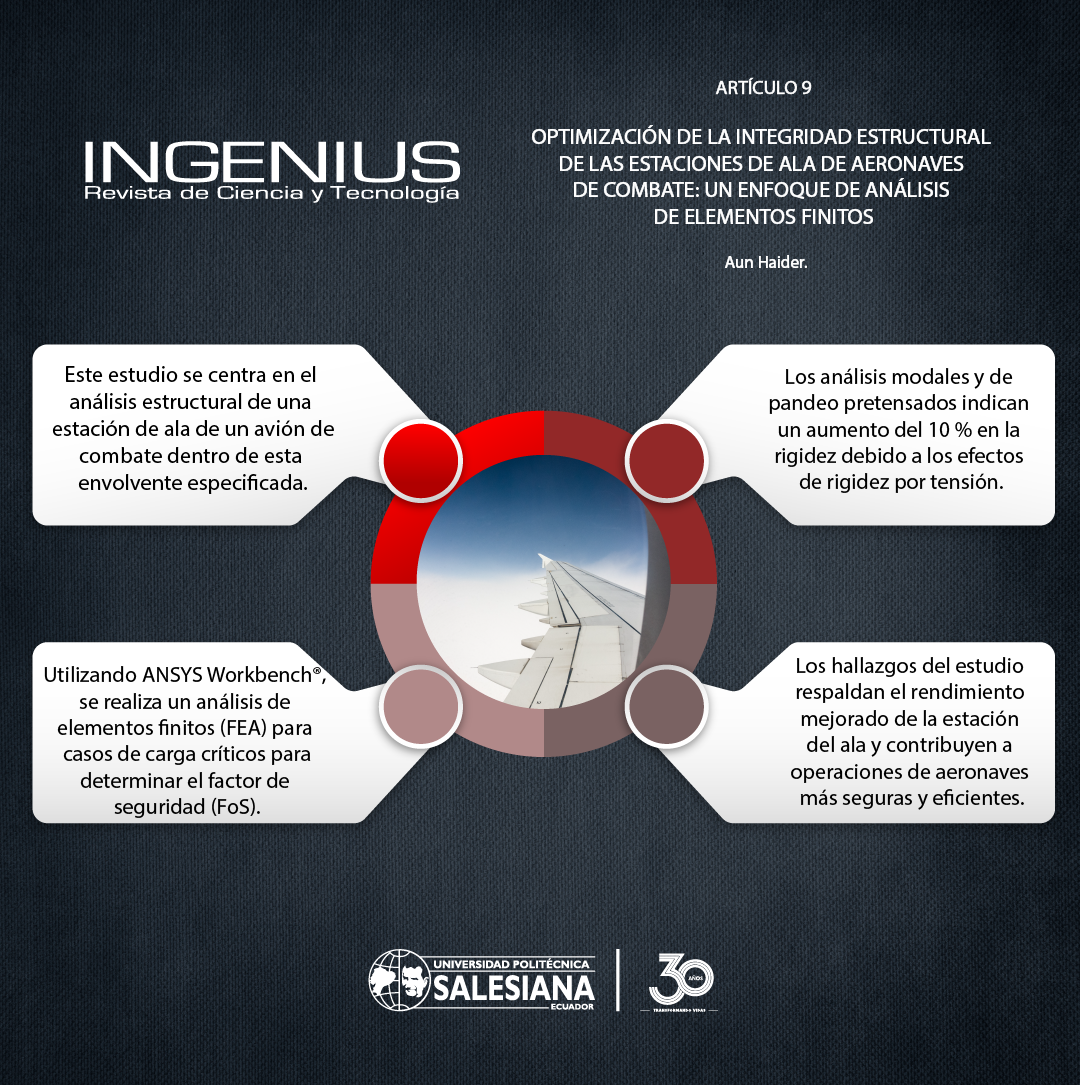Optimizing Structural Integrity of Fighter Aircraft Wing Stations: a Finite Element Analysis Approach
Main Article Content
Abstract
Article Details

This work is licensed under a Creative Commons Attribution-NonCommercial-ShareAlike 4.0 International License.
The Universidad Politécnica Salesiana of Ecuador preserves the copyrights of the published works and will favor the reuse of the works. The works are published in the electronic edition of the journal under a Creative Commons Attribution/Noncommercial-No Derivative Works 4.0 Ecuador license: they can be copied, used, disseminated, transmitted and publicly displayed.
The undersigned author partially transfers the copyrights of this work to the Universidad Politécnica Salesiana of Ecuador for printed editions.
It is also stated that they have respected the ethical principles of research and are free from any conflict of interest. The author(s) certify that this work has not been published, nor is it under consideration for publication in any other journal or editorial work.
The author (s) are responsible for their content and have contributed to the conception, design and completion of the work, analysis and interpretation of data, and to have participated in the writing of the text and its revisions, as well as in the approval of the version which is finally referred to as an attachment.
References
K. Sinha, T. Klimmek, M. Schulze, and V. Handojo, “Loads analysis and structural optimization of a high aspect ratio, composite wing aircraft,” CEAS Aeronautical Journal, vol. 12, no. 2, pp. 233–243, Apr 2021. [Online]. Available: https://doi.org/10.1007/s13272-021-00494-x
B. D. Upadhyay, S. S. Sonigra, and S. D. Daxini, “Numerical analysis perspective in structural shape optimization: A review post 2000,” Advances in Engineering Software, vol. 155, p. 102992, 2021. [Online]. Available: https://doi.org/10.1016/j.advengsoft.2021.102992
N. Zimmermann and P. H. Wang, “A review of failure modes and fracture analysis of aircraft composite materials,” Engineering Failure Analysis, vol. 115, p. 104692, 2020. [Online]. Available: https://doi.org/10.1016/j.engfailanal.2020.104692
R. L. Muhanna and S. Shahi, Uncertainty in Boundary Conditions—An Interval Finite Element Approach. Cham: Springer International Publishing, 2020, pp. 157–167. [Online]. Available: https://doi.org/10.1007/978-3-030-40814-5_20
T. Martins, V. Infante, L. Sousa, A. Fonseca, P. Antunes, A. Moura, and B. Serrano, “Numerical and experimental study of aircraft structural health,” International Journal of Fatigue, vol. 132, p. 105348, 2020. [Online]. Available: https://doi.org/10.1016/j.ijfatigue.2019.105348
J. Lim, C. You, and I. Dayyani, “Multi-objective topology optimization and structural analysis of periodic spaceframe structures,” Materials & Design, vol. 190, p. 108552, 2020. [Online]. Available: https://doi.org/10.1016/j.matdes.2020.108552
C. Touzé, A. Vizzaccaro, and O. Thomas, “Model order reduction methods for geometrically nonlinear structures: a review of nonlinear techniques,” Nonlinear Dynamics, vol. 105, no. 2, pp. 1141–1190, Jul 2021. [Online]. Available: https://doi.org/10.1007/s11071-021-06693-9
C. You, M. Yasaee, S. He, D. Yang, Y. Xu, I. Dayyani, H. Ghasemnejad, S. Guo, P. Webb, J. Jennings, and G. Federico, “Identification of the key design inputs for the fem-based preliminary sizing and mass estimation of a civil aircraft wing box structure,” Aerospace Science and Technology, vol. 121, p. 107284, 2022. [Online]. Available: https://doi.org/10.1016/j.ast.2021.107284
A. Haider Bhutta, “Appropriate boundary condition for finite element analysis of structural members isolated from global model,” NED University Journal of Research, vol. 18, no. 3, pp. 61–75, 2021. [Online]. Available: https://doi.org/10.35453/NEDJR-STMECH-2021-0001
E. Narvydas, N. Puodziuniene, and T. A. khan, “Application of finite element sub-modeling techniques in structural mechanics,” Mechanika, vol. 27, no. 6, pp. 459–464, 2021. [Online]. Available: https://doi.org/10.5755/j02.mech.25962
J. Jang and S. Ahn, “Fe modeling methodology for load analysis and preliminary sizing of aircraft wing structure,” International Journal of Aviation, Aeronautics, and Aerospace, vol. 6, no. 2, 2019. [Online]. Available: https://doi.org/10.15394/ijaaa.2019.1301
A. Mishra, S. Pal, G. Singh Malhi, and P. Singh, “Structural analysis of uav airframe by using fem techniques: A review,” International Journal of Advanced Science and Technology, vol. 29, pp. 195–204, 06 2020. [Online]. Available: https://is.gd/4NRfx9
S. Henclik and A. Maurin, “Determination of the stiffness matrix of flat springs for modeling of the boundary condition at a pipeline support,” Mechanical Systems and Signal Processing, vol. 123, pp. 102–116, 2019. [Online]. Available: https://doi.org/10.1016/j.ymssp.2018.12.047
M. d. C. Alves, F. N. Corrêa, J. R. M. de Sousa, and B. P. Jacob, “A coupled, global/local finite element methodology to evaluate the fatigue life of flexible risers attached to floating platforms for deepwater offshore oil production,” Mathematics, vol. 12, no. 8, 2024. [Online]. Available: https://doi.org/10.3390/math12081231
V. Karnozov, “China’s fighter aircraft detailed,” Defence Review Asia, vol. 13, no. 1, pp. 42–47, 2019. [Online]. Available: https://is.gd/dM2DHD
A. G. Manca and C. M. Pappalardo, “Topology optimization procedure of aircraft mechanical components based on computer-aided design, multibody dynamics, and finite element analysis,” in Advances in Design, Simulation and Manufacturing III, V. Ivanov, I. Pavlenko, O. Liaposhchenko, J. Machado, and M. Edl, Eds. Cham: Springer International Publishing, 2020, pp. 159–168. [Online]. Available: https://doi.org/10.1007/978-3-030-50491-5_16
A. Aabid, M. A. M. B. M. Zakuan, S. A. Khan, and Y. E. Ibrahim, “Structural analysis of three-dimensional wings using finite element method,” Aerospace Systems, vol. 5, no. 1, pp. 47–63, Mar 2022. [Online]. Available: https://doi.org/10.1007/s42401-021-00114-w
P. Wang, Y. Chen, R. Pei, C. Lian, K. Zhang, and Y. Zhou, “Buckling and post-buckling analysis of composite wing box under loads with torsion-bending coupling,” Thin-Walled Structures, vol. 193, p. 111266, 2023. [Online]. Available: https://doi.org/10.1016/j.tws.2023.111266
N. Yang, “Methodology of aircraft structural design optimisation,” International Journal of Computer Applications in Technology (IJCAT), vol. 70, no. 3, pp. 145–154, 2022. [Online]. Available: https://dx.doi.org/10.1504/IJCAT.2022.130874
A. Basutkar, K. Baruah, and S. K. Kudari, “Frequency analysis of aircraft wing using FEM,” in Recent Trends in Mechanical Engineering, G. S. V. L. Narasimham, A. V. Babu, S. S. Reddy, and R. Dhanasekaran, Eds. Singapore: Springer Singapore, 2020, pp. 527–533. [Online]. Available: https://doi.org/10.1007/978-981-15-1124-0_46
B. Ravi Kumar, “Investigation on buckling response of the aircraft’s wing using finite-element method,” Australian Journal of Mechanical Engineering, vol. 18, no. sup1, pp. S122–S131, 2020. [Online]. Available: https://doi.org/10.2514/1.C034818
S. De, M. Jrad, and R. K. Kapania, “Structural optimization of internal structure of aircraft wings with curvilinear spars and ribs,” Journal of Aircraft, vol. 56, no. 2, pp. 707–718, 2019. [Online]. Available: https://doi.org/10.2514/1.C034818

